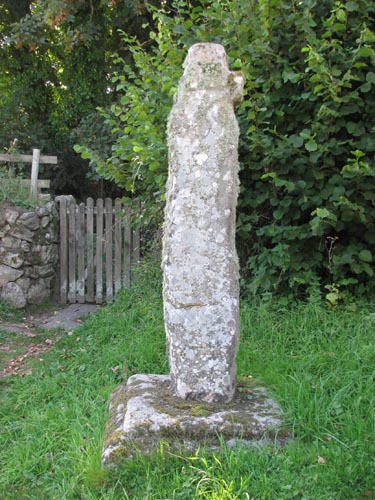 Location:
From the lych gate to the churchyard,
opposite the village green, take the path which leads pass the south door
to the church and the cross will be seen ahead of you. Location:
From the lych gate to the churchyard,
opposite the village green, take the path which leads pass the south door
to the church and the cross will be seen ahead of you.O/S Grid Ref: SX/74912/81272 Longitude/Latitude (Degrees+/-): -3.76953/50.61770 Map location: Click here to view map. Purpose: Churchyard Cross. Size: 6 feet (1.83 metres) tall. The shaft measures 1 foot (0.30 metres) square. The inscribed cross on each face measures 7 inches high (0.18 metres) and 7 inches (0.18 metres) across the arms. Information: From its roughly hewn nature, it can be deduced that this ancient cross was originally erected somewhere outside the village as a waymarker. Unfortunately, one arm is now completely missing and the other has been so badly damaged that it is not possible to guess, with any accuracy, what the width across the arms would have been. However, the distance from the centre of the shaft to the outer edge of the remaining arm is 8 inches (0.20 metres). This shows that the original width across the arms was at least 1 foot 4 inches (0.40 metres), but the likelihood is that it was somewhat more than this. There is an incised cross in the centre of each face of the cross. The cross sits in a square socket stone, set on a pedestal of two steps. That the cross does not match the socket stone is shown by the fact that the latter has been carefully worked, with even sides and with mouldings being fashioned around the neatly chamfered top edges. The lower step of the pedestal measures 3 feet 3inches (1.00 metres) square and 10 inches (0.25 metres) high. The smaller upper step is 2 feet 9 inches (0.84 metres) square and 3 inches (0.08 metres) high.
The socket stone stood empty until the discovery of the current cross, in 1908, by a local man who was commissioned to undertake some work on the church bells. During his lunch break one day, he decided to go for a stroll down the lane leading away from the church. At a point where he reached a small stream, he noticed an unusual stone being used as a lintel to carry a wall across the stream. He could see a small incised cross cut into the face of the stone and it also looked to have the remains of an arm. After it had been positively identified as a cross, the Rector arranged for it to be rescued and set up in the vacant socket stone inside the churchyard. Although this cross is more of a waymarker than a churchyard cross and it obviously does not fit the socket stone, the current arrangement now provides the cross with some protection and allows us all access to view it.
Between the lych gate and the church stands a fine memorial cross, erected to the memory of the men of Manaton who fell in the two world wars. |